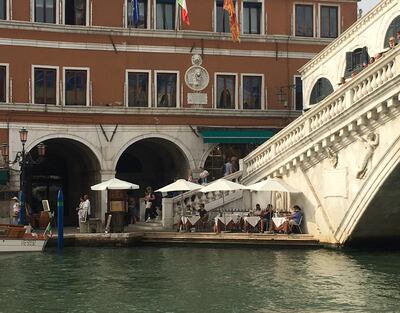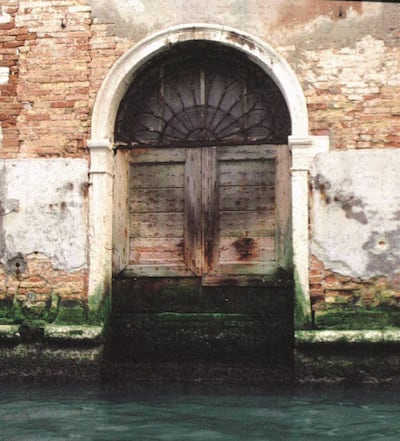A man is falling out of a skyscraper and with a silly grin on his face, he is saying, “So far, so good”, as he whizzes past the 20th floor.
This is the greatest difficulty that experts at the Cop26 climate conference have to deal with, even more than entrenched financial interests: the psychological trait we all have of projecting into the future on the basis of past experience. It hasn’t happened yet, so it’s not going to happen in the future. We need strong images to stir our emotions, to make us visualise that we are in danger. Venice, like the photo of the lonely polar bear on his melting ice floe, is such an image.
The rise in temperature is melting the ice at the poles and that is a major reason why the seas are rising. In 1900, a photographer took a picture by Venice's famous Rialto Bridge and you can see six clean steps going down into the Grand Canal. A friend of mine went out in his boat and photographed the same view, but now only one step is free of algae, which means that the others are underwater at every high tide. The level of the water relative to the land in Venice is nearly 40 centimetres higher than it was in 1897, when scientific measurements began to be taken, and more than half of that is from sea-level rise, the rest being due to subsidence.
Global warming is accelerating. The most authoritative scientific body in the field, consulted by most governments, the IPCC – or the Intergovernmental Panel on Climate Change – issued its sixth report this summer and it predicts a rise in relative sea level of 28-55cm by the year 2100 in its most optimistic estimate of global warming, that is, if we manage to keep it below 2°C. In its intermediate estimate – considered the most likely – of an increase in temperature of 2.1-3.5°C, the rise in relative sea level is projected to be 44-76cm.


Go back to the photograph and you can imagine that Venice may well be almost continuously flooded, and it's going to happen within the lifetimes of our grandchildren. The permanently raised water level will accelerate the degradation of the ancient buildings, crumbling the brickwork and rusting through the iron tie rods that hold them together. Venice will not disappear elegantly below the waves, but will rot, falling down bit by bit, a ghastly reminder of our incapacity to plan ahead and act. Two hundred years ago, the poet Byron imagined how we shall mourn (although he probably never thought it would really happen). “O Venice, Venice, when thy marble walls are level with the waters, there shall be a cry of nations o’er thy sunken hall, a loud lament along the sweeping sea,” he wrote.
But wait a bit, you may say: doesn’t Venice have mobile barriers to close off the lagoon from the sea? It does. In fact, they were successfully closed last week and stopped the excess water from invading the city. But they are designed for temporary flooding events that rarely last more than 24 hours. They cannot be kept permanently closed because the lagoon, which needs to exchange water with the open sea twice a day to stay healthy, would, under present conditions, become a stinking swamp, as damaging to the city as it would be unsustainable.
These barriers, known as Mose, were planned back in the 1980s before climate change was a well-known concept. They have been beset by huge corruption and delays and have caused endless political rows. Not surprisingly, politicians roll their eyes when they are told by the scientists that another, different solution needs to be invented now.

This connection between what the scientists tell us and what the decision-makers do is at the heart of the climate change challenge. When do we know enough? What persuades us that we really must act (I say we, because we are all of us involved in this process)?
Mark Carney, the previous governor of the Bank of England, said in his BBC Reith Lectures that climate change will be resolved quickly when businesses understand that it can be profitable to deal with it. Whenever that may be, it will certainly need us to start thinking longer term than we have been used to. The Dutch, who have lived for centuries managing the violence of the North Sea and who will die if they get it wrong, have the Delta Programme, a national plan that is working on the basis of four scenarios, the lowest with sea-level rise of 40cm by 2100, the highest with 100cm. And just in case even that is overtopped, they have a team projecting what might happen if it is as high as two metres.
Planning ahead is challenging. That is why one of the Italy's most distinguished learned bodies, the Istituto Veneto di Scienze, Lettere ed Arti, has now appealed to Prime Minister Mario Draghi, former head of the European Central Bank, to take the matter of the protection of Venice in hand. He is known to be worried about Italy’s total lack of preparedness for sea-level rise and is very influential in EU governing circles. Many of the fellows of the Istituto Veneto, including myself, believe that the case of Venice – as indeed most of the places at risk around the world – is not a national but an international challenge. It could provide an opportunity to share knowledge and skill and to work with neighbouring countries, who may not always be our closest friends, for the sake of the common good. In the meantime, anyone have the number of the head of the Dutch Delta Programme? Anyone?

